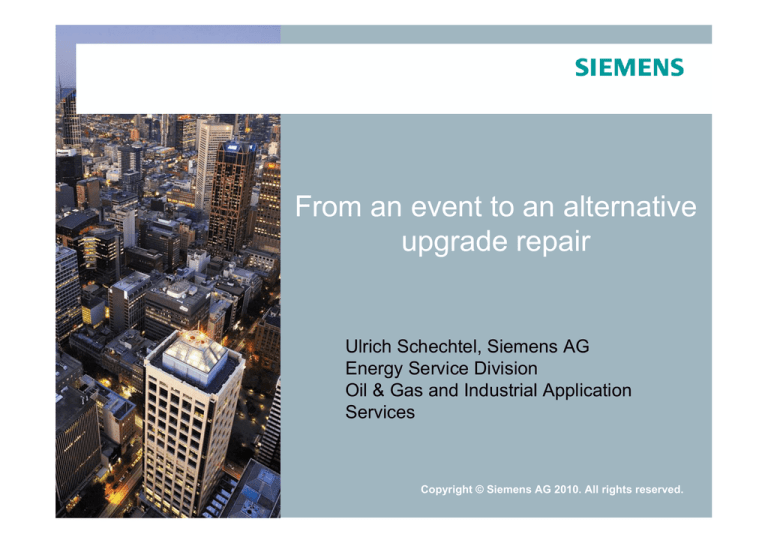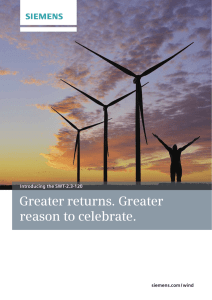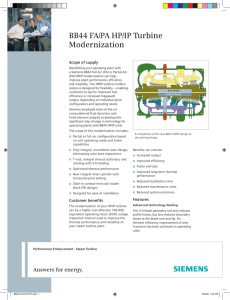
From an event to an alternative
upgrade repair
Ulrich Schechtel, Siemens AG
Energy Service Division
Oil & Gas and Industrial Application
Services
Copyright © Siemens AG 2010. All rights reserved.
Table of contents
Event at an industrial steam turbine
Repair options
Repair / modernization
Page 2
June 2010
Ulrich Schechtel
Copyright © Siemens AG 2010. All rights reserved.
Energy Sector
Event
When reaching approx. 30% nominal speed at the start up of the
steam turbine – built in 1971 – a sudden and strong vibration increase
was monitored. The turbine was stopped.
Activities:
External inspection and measurements at turbine rotor
Opening of the steam turbine
Fact-finding of components on site
Constructional check/validation of repair options
Quote for an economical repair / modernization solution
Page 3
June 2010
Ulrich Schechtel
Copyright © Siemens AG 2010. All rights reserved.
Energy Sector
Event
Steam turbine design
Technical data:
Page 4
June 2010
Ulrich Schechtel
Life steam:
26,0 bar / 355°C
Back pressure:
2,48 bar
Speed:
3000 rpm
Terminal output:
14,07 MW
Built in:
1971
Drive:
Generator
Copyright © Siemens AG 2010. All rights reserved.
Energy Sector
Event
Damage at stationary internals
Major damage at stationary blades
starting at stationary row 8
Heavily corroded stationary
turbine internals
Page 5
June 2010
Ulrich Schechtel
Copyright © Siemens AG 2010. All rights reserved.
Energy Sector
Event
Damage at stationary internals
Stationary
blades with
heavy pitting
Page 6
June 2010
Ulrich Schechtel
Nozzle blades with heavy
corrosion and eroded trailing
edges
Copyright © Siemens AG 2010. All rights reserved.
Energy Sector
Event
Damage at rotor
Fracture at
rotor blade rows 8 - 23
Page 7
June 2010
Ulrich Schechtel
Copyright © Siemens AG 2010. All rights reserved.
Energy Sector
Event
Damage at rotor
Rotor blade row 1 – 7
without break
Heavy corrosion
Page 8
June 2010
Ulrich Schechtel
Copyright © Siemens AG 2010. All rights reserved.
Energy Sector
Event
Damage at turbine
Cause of damage ?
Page 9
June 2010
Ulrich Schechtel
Copyright © Siemens AG 2010. All rights reserved.
Energy Sector
Event
Damage at turbine
Cause:
Concluded to be fracture of blading due to strong corrosion
gaps with feasible
concentration of
moisture and
deposits
pitting
model
stationary blading
Page 10
June 2010
Ulrich Schechtel
Copyright © Siemens AG 2010. All rights reserved.
Energy Sector
Event
Damage at turbine
Pitting at blading reveal
Locally increased bending stresses
Fatigue stress concentration with
dynamic loading (notch effect)
Row 8
stationary blade
262,9 MPa
262,9 MPa
Page 11
June 2010
Ulrich Schechtel
Copyright © Siemens AG 2010. All rights reserved.
Energy Sector
Event
Damage at turbine
Change of blading
natural frequency
stress level at mode 1 of
natural blade frequency
Mode 1
Page 12
June 2010
Mode 3
Ulrich Schechtel
Copyright © Siemens AG 2010. All rights reserved.
Energy Sector
Repair options
Option 1:
Option 2:
Repair according original design:
Modernization:
Exchange of 23 freestanding stages
Re-use of original rotor and casing for modernization
Exchange of impulse stage
(cost and delivery time - factors)
Stress annealing of rotor due to rubbing
Assembly of 16 stages with state of the art
shrouding blading
Remachining of rotor to eliminate damaged rubbing
Considerations:
Less efficiency (compared to actual design)
Modest reliability of freestanding blading
7 stages more (higher fabrication costs)
sections
Considerations:
More engineering efforts required
Advantage:
Strongly improved efficiency
Advantage:
(performance increased by 880 kW / 6,3%)
Reduced engineering costs
Increased reliability
Page 13
June 2010
Ulrich Schechtel
Copyright © Siemens AG 2010. All rights reserved.
Energy Sector
Repair options
Option 1: Repair based on original design
Stationary - and
rotating blades with
intermediate pieces
Page 14
June 2010
Rotating blades
with bulged foot
Ulrich Schechtel
Control stage with
rivet head
Copyright © Siemens AG 2010. All rights reserved.
Energy Sector
Repair options
Option 2: Modern blading design
Shrouded blading design 1 st Generation
Original free-standing type of blading
Rotating blade with
integral shrouding
and inverted T-root
Rotating
blades cut
from bars
Stationary
blade
Spacers with
serrated
fixing
Small axial
distance
Stationary
blades cut
from bars
Riveted-on
shrouding
Caulked-in
sealing
strips
Rotor
Page 15
June 2010
Ulrich Schechtel
Copyright © Siemens AG 2010. All rights reserved.
Energy Sector
Repair Options
Option 2: Modern blading design
Shrouded blade design 1st generation
Shrouded blade design 2nd generation
Stator
Rotor
Page 16
June 2010
Ulrich Schechtel
Copyright © Siemens AG 2010. All rights reserved.
Energy Sector
Repair options
Option 2: Modernization
Guide blades with
riveted shroud bands
Rings with EDM-cut
profiles for guide blades
Integral shrouding
(final machining
after installation)
Improved
Surface smoothness
Shrouded rotor blade
2nd generation
Page 17
June 2010
Shrouded guide blade with guide ring
2nd generation
Ulrich Schechtel
Copyright © Siemens AG 2010. All rights reserved.
Energy Sector
Repair / modernisation
Original and modified stationary blade section
Original design with 23 stages
New blading with 16 stages only
and up to 6,3 % output increase*
Installation of radially
fixed bushings
*Examples for illustration only – actual results may vary
Page 18
June 2010
Ulrich Schechtel
Copyright © Siemens AG 2010. All rights reserved.
Energy Sector
Repair / modernisation
Original and new rotor contour / blade section
Original rotor
contour
New contour and grooves for
shrouded blades
Smaller balance piston
diameter
Page 19
June 2010
Ulrich Schechtel
Copyright © Siemens AG 2010. All rights reserved.
Energy Sector
Repair / modernisation
Completed stator rows, partly bladed rotor
and turbine during assembly
Page 20
June 2010
Ulrich Schechtel
Copyright © Siemens AG 2010. All rights reserved.
Energy Sector
Repair / modernization
Turbine casing at final assembly
New air dry
connection
Page 21
June 2010
Ulrich Schechtel
Copyright © Siemens AG 2010. All rights reserved.
Energy Sector
Optimization benefits
Benefits can include:
Optimized power output and improved
earnings due to improved efficiency
Recapture of some performance degradation
Higher availability and reliability
Application of advanced turbine components
Shorter conversion and outage period
compared to installation of new machinery
Greater use of existing components
Page 22
June 2010
Ulrich Schechtel
Copyright © Siemens AG 2010. All rights reserved.
Energy Sector
Disclaimer
This document contains forward-looking statements and information – that is, statements related to future, not past,
events. These statements may be identified either orally or in writing by words as “expects”, “anticipates”, “intends”,
“plans”, “believes”, “seeks”, “estimates”, “will” or words of similar meaning. Such statements are based on our current
expectations and certain assumptions, and are, therefore, subject to certain risks and uncertainties. A variety of
factors, many of which are beyond Siemens’ control, affect its operations, performance, business strategy and results
and could cause the actual results, performance or achievements of Siemens worldwide to be materially different from
any future results, performance or achievements that may be expressed or implied by such forward-looking
statements. For us, particular uncertainties arise, among others, from changes in general economic and business
conditions, changes in currency exchange rates and interest rates, introduction of competing products or technologies
by other companies, lack of acceptance of new products or services by customers targeted by Siemens worldwide,
changes in business strategy and various other factors. More detailed information about certain of these factors is
contained in Siemens’ filings with the SEC, which are available on the Siemens website, www.siemens.com and on
the SEC’s website, www.sec.gov. Should one or more of these risks or uncertainties materialize, or should underlying
assumptions prove incorrect, actual results may vary materially from those described in the relevant forward-looking
statement as anticipated, believed, estimated, expected, intended, planned or projected. Siemens does not intend or
assume any obligation to update or revise these forward-looking statements in light of developments which differ from
those anticipated.
Trademarks mentioned in this document are the property of Siemens AG, it's affiliates or their respective owners.
Page 23
June 2010
Ulrich Schechtel
Copyright © Siemens AG 2010. All rights reserved.
Energy Sector
Many thanks for your kind attention !
Page 24
June 2010
Ulrich Schechtel
Copyright © Siemens AG 2010. All rights reserved.
Energy Sector




